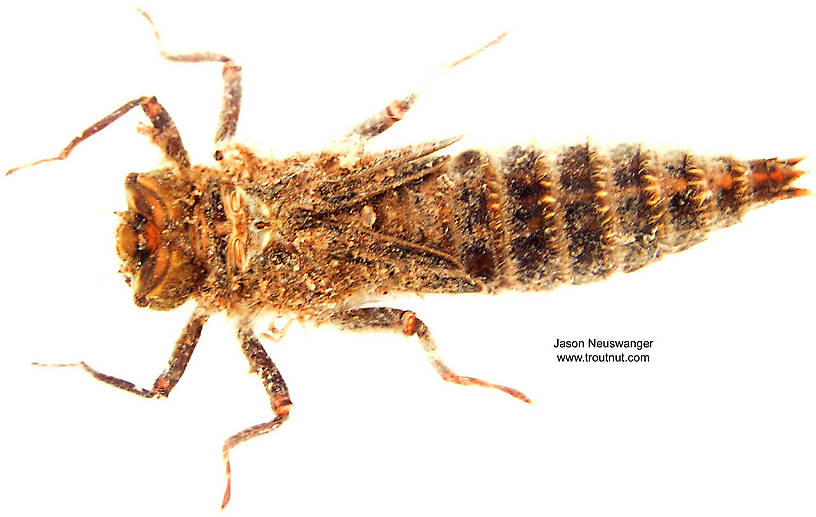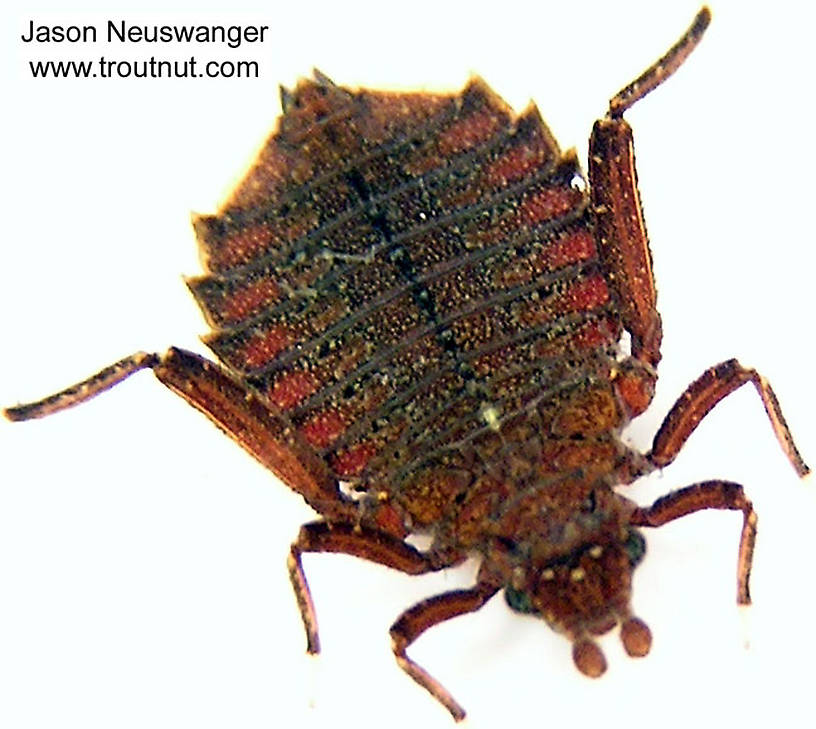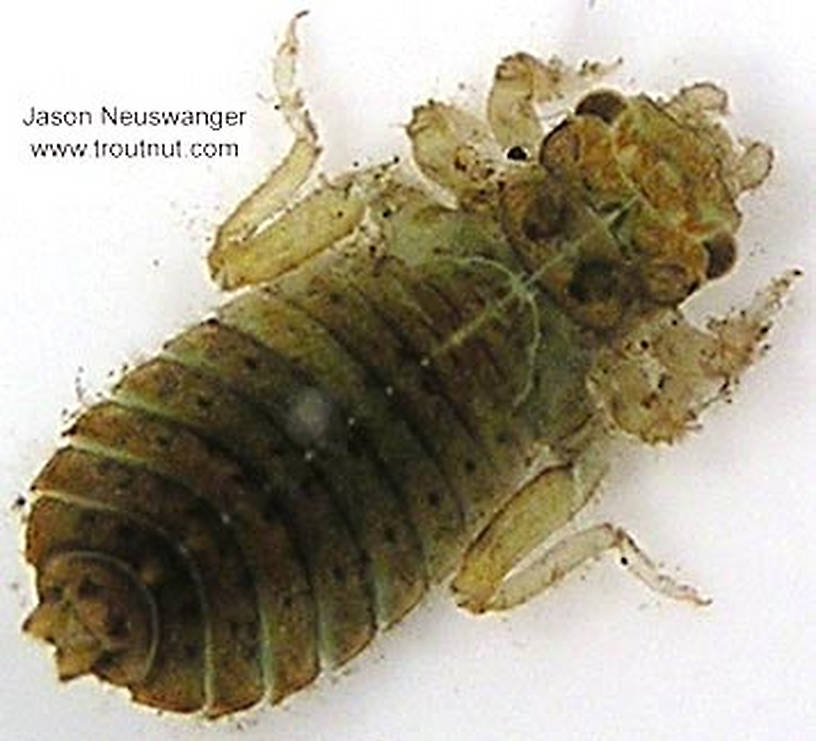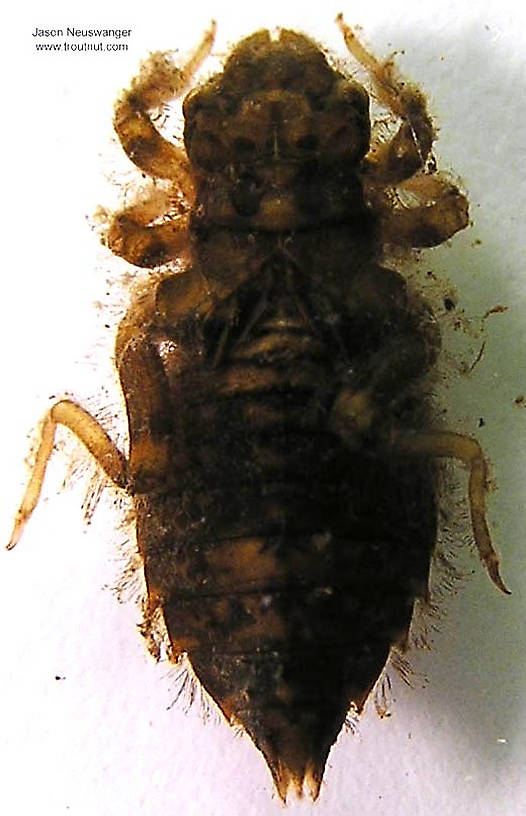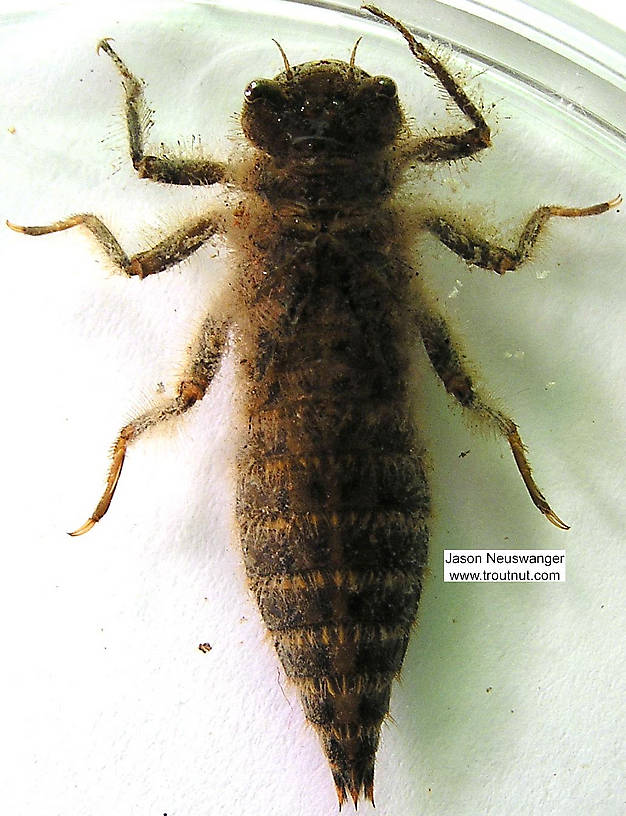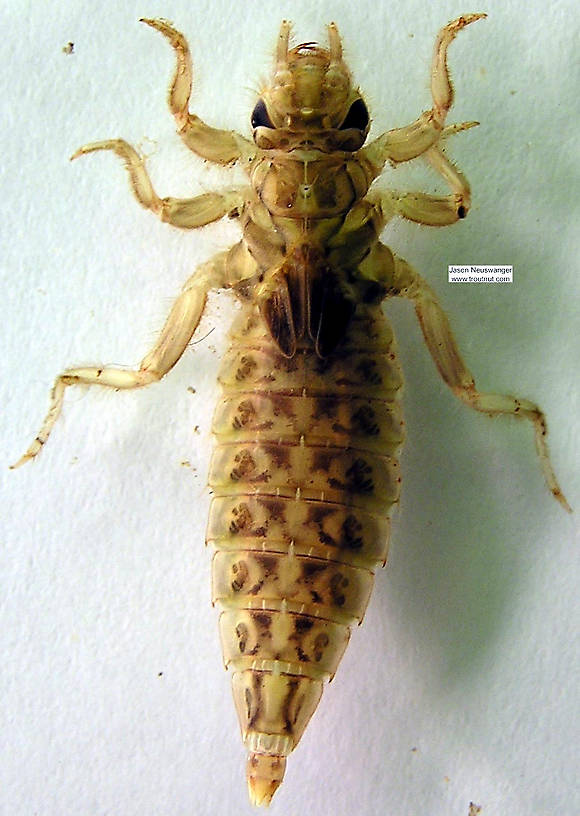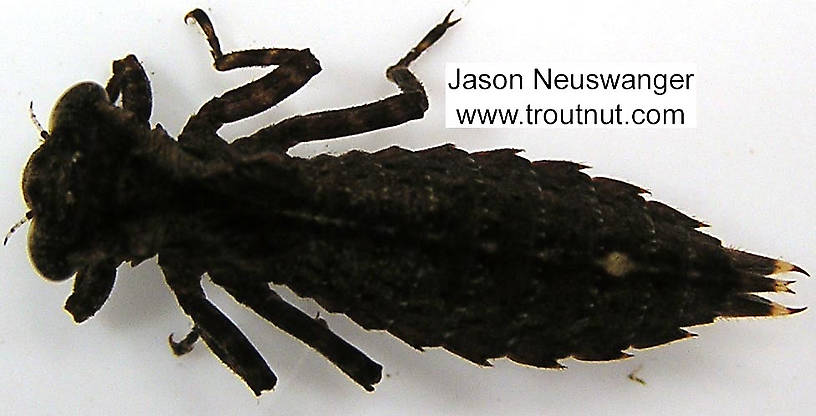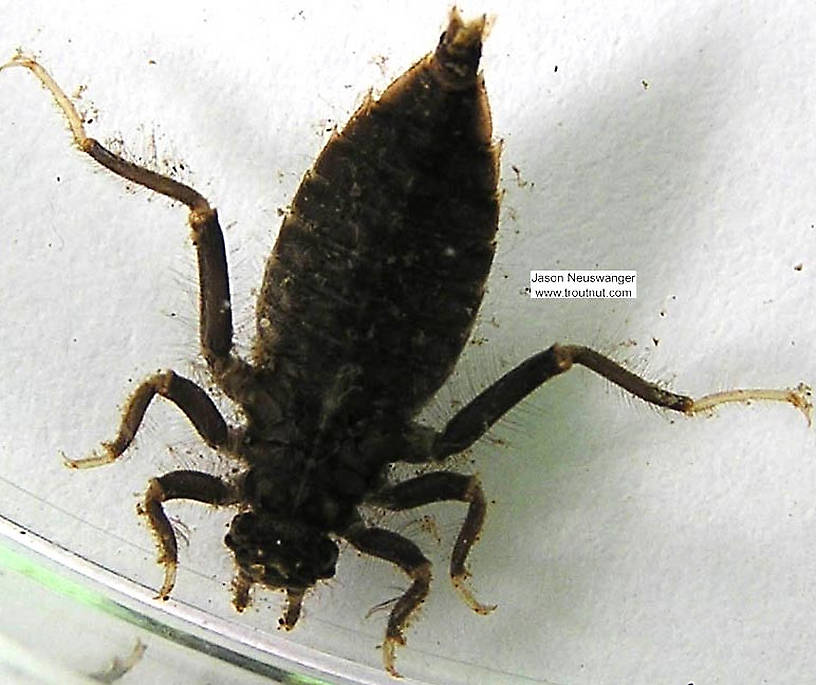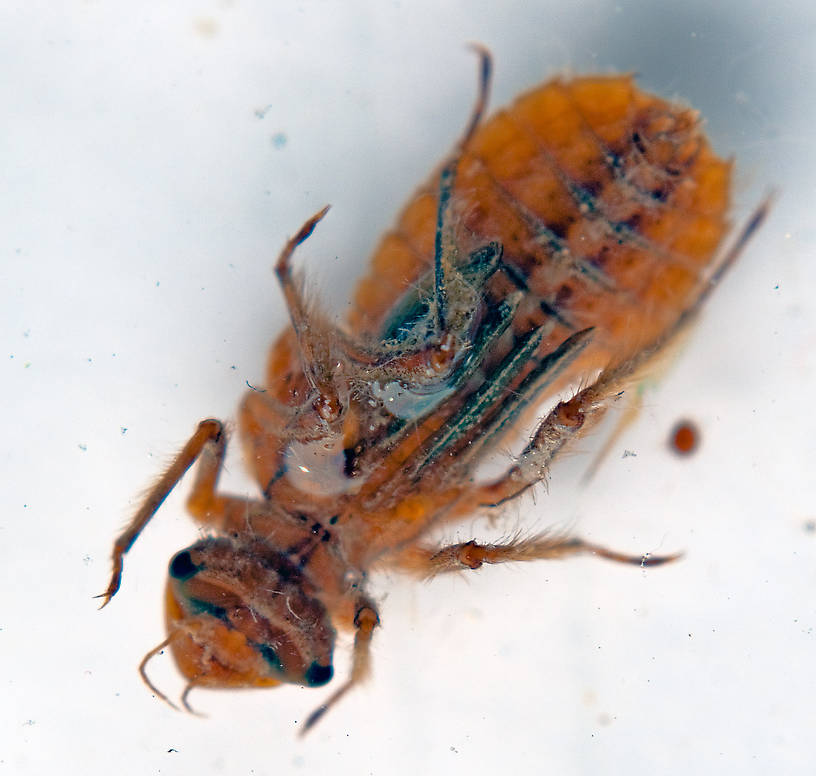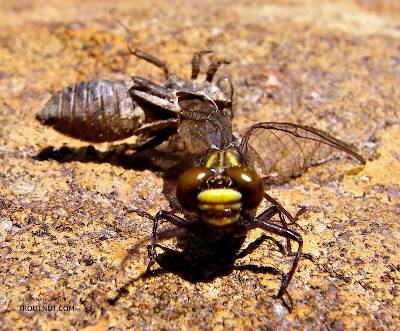
Hex Mayflies
Hexagenia limbata
The famous nocturnal Hex hatch of the Midwest (and a few other lucky locations) stirs to the surface mythically large brown trout that only touch streamers for the rest of the year.
Featured on the forum

This specimen keys pretty easily to Onocosmoecus, and it closely resembles a specimen from Alaska which caddis expert Dave Ruiter recognized as this genus. As with that specimen, the only species in the genus documented in this area is Onocosmoecus unicolor, but Dave suggested for that specimen that there might be multiple not-yet-distinguished species under the unicolor umbrella and it would be best to stick with the genus-level ID. I'm doing the same for this one.

Troutnut is a project started in 2003 by salmonid ecologist Jason "Troutnut" Neuswanger to help anglers and
fly tyers unabashedly embrace the entomological side of the sport. Learn more about Troutnut or
support the project for an enhanced experience here.
Insect Order Odonata-Anisoptera (Dragonflies)
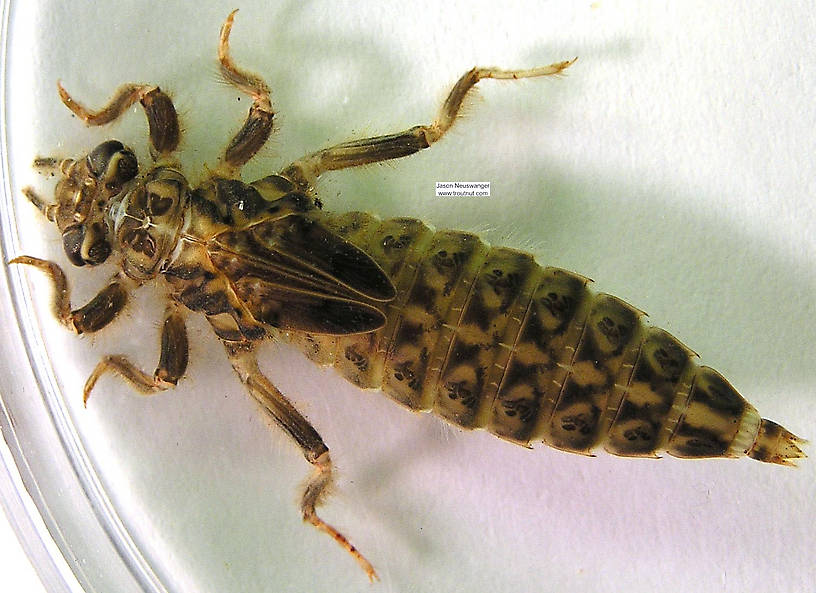
Hatching behavior
Dragonfly nymphs emerge by crawling up various objects out of the water, so the emergence is not important. Freshly emerged flies may have a little trouble flying and end up on the water, but emergence is so sporadic that this activity never causes a good rise of fish, let alone selective feeding. The lone, struggling stray may draw an explosive rise.Egg-Laying behavior
Adult dragonflies are so good at flying that they very rarely end up on the water and never in good numbers. They live for a long time as adults and feed heavily on other insects in mid-air. It's great fun to watch one twist its way through a cloud of tiny midges with aerial maneuvers beyond Lockheed Martin's wildest dreams. Dragonflies are also good indicators of impending mayfly spinner falls: just like swallows and waxwings, they swoop among the spinner swarms at treetop level long before the smaller mayflies are low enough to be spotted.Nymph biology
Diet: Other insects, small fish
Specimens of Dragonflies:
1 Adult
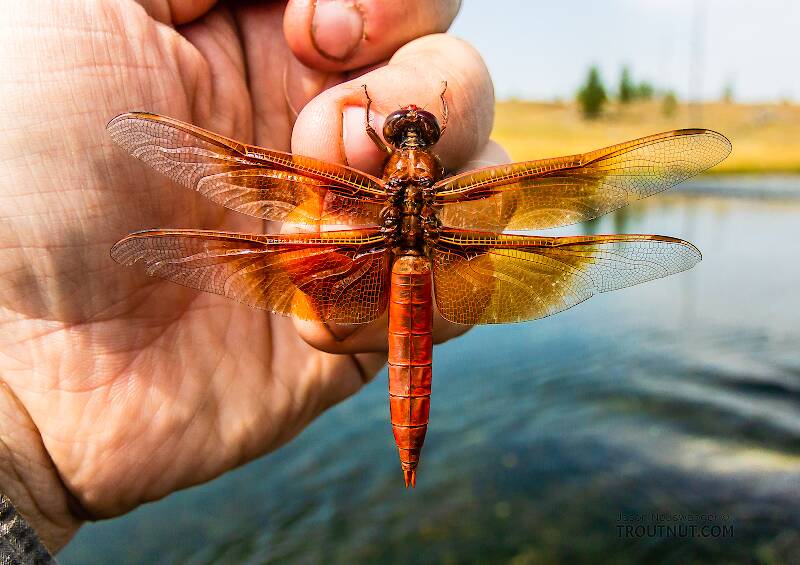
This specimen of Libella saturata, the flame skimmer dragonfly, is the only invertebrate in this site's collection that I caught by hook and line. It swooped down and attacked my dry fly on the Firehole River, where it lived as a nymph in the hot water near the geothermal springs and geyser runoff.
10 Nymphs
1 Streamside Picture of Dragonflies:
Discussions of Odonata-Anisoptera
Emerging Dragonflies
5 replies
Posted by AlexC on Jun 11, 2007
Last reply on Dec 9, 2007 by WildcatRob
Whle fishing the West Branch of the Ausable River this weekend I came across an area that had dozens of empty dragon fly nypmh shucks on the rocks. There was a small feeder stream right by this area.
I fished another spot where there was a small feeder stream, and again, there were dozens of empty dragonfly nymph shuck here too.
These were the only places I saw any empty shucks and was just curious if it wasn't just a coincidence that both areas where the nymphs chose to emerge were near feeder streams?
I fished another spot where there was a small feeder stream, and again, there were dozens of empty dragonfly nymph shuck here too.
These were the only places I saw any empty shucks and was just curious if it wasn't just a coincidence that both areas where the nymphs chose to emerge were near feeder streams?
Neat dragonfly observation by Martinlf
Posted by Troutnut on Dec 7, 2006
Last reply on Dec 7, 2006 by Troutnut
Our great discussion of hellgrammites included a very interesting little tangent about the feeding habits of dragonflies which I'm copying into the dragonfly section.
Martinlf wrote:
Gonzo replied:
I love watching dragonflies feed on mayflies, but I admit I've never noticed the falling discards. I'll keep an eye out for them next season. A good photo sequence of the phenomenon would be awesome, but I think my photography skills would need to jump several orders of magnitude to capture such a thing in action.
Martinlf wrote:
This is pure trivia, and non-hellgrammite related, but Brett's comments on the discards of bats and nighthawks reminded me of an experience on the Delaware. I was fishing with a guide and we saw several mayfly wing and thorax combos floating along with missing abdomens. At first we hypothesized that a small trout must have bitten the abdomen right off. Then we saw a dragonfly intercept a sulphur mid flight, chew up the abdomen almost instantly, and let the wings and thorax fall, helicoptering like a winged maple seed. This is probably not news to the entomologists here, but some everyday anglers might not have yet noticed this phenomenon. Gonzo, do we have a wing and thorax tie yet?
Gonzo replied:
Louis,
I haven't found trout to be that interested in dragonfly discards, but you never know. I am reminded of an evening on Mud Run when my fishing partner's fly mysteriously ascended skyward, towing a good portion of the tip of his fly line. His fly, while having a minimal effect on the trout we were pursuing, was sufficiently convincing to a large dragonfly--a testament to the powerful flight and lifting capabilities of these insects!
I love watching dragonflies feed on mayflies, but I admit I've never noticed the falling discards. I'll keep an eye out for them next season. A good photo sequence of the phenomenon would be awesome, but I think my photography skills would need to jump several orders of magnitude to capture such a thing in action.
Differentiation b/t Gomphidae and Cordulegastridae
1 replies
Posted by DMM on Nov 26, 2006
Last reply on Nov 29, 2006 by Troutnut
This goes for all Gomphidae. If the prementum is flat, and the animal has 4 segments in each antenna, and two-segmented fore and middle tarsi, and a ligula with no median cleft--Gomphid. The Corduligastridae have a spoon-shaped prementum and a cleft in the middle of toothlike processes on ligula. Now you'll know whenever you catch more Odonata.
Start a Discussion of Odonata-Anisoptera
References
- Schwiebert, Ernest G. 1955. Matching the Hatch. MacMillan Publishing Company.
- Swisher, Doug and Carl Richards. 2000. Selective Trout. The Lyons Press.
Insect Order Odonata-Anisoptera (Dragonflies)
Taxonomy
2 families (Corduliidae and Petaluridae) aren't included.


